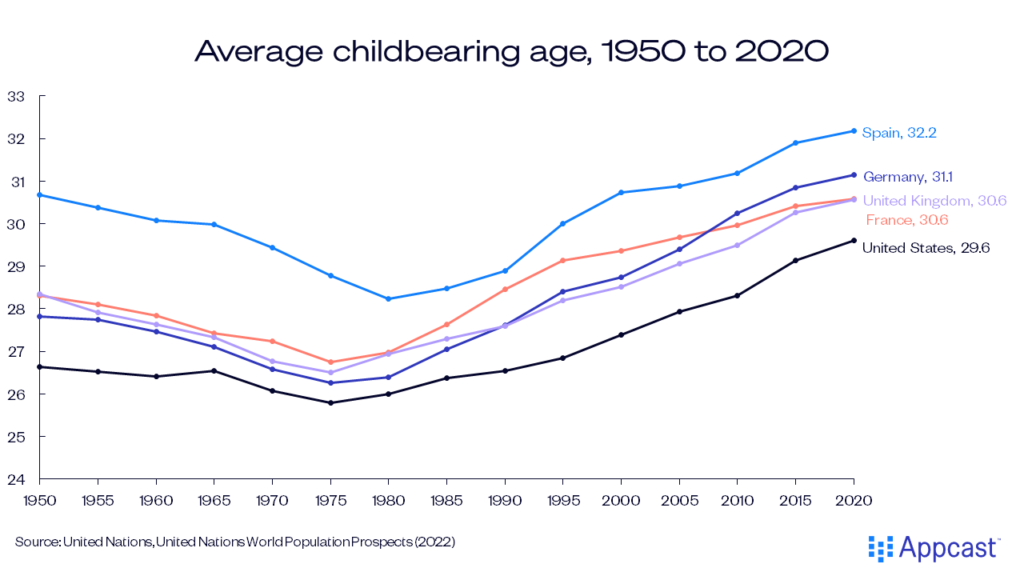The global fertility crisis
Fertility rates across advanced economies have fallen dramatically and are expected to remain low indefinitely. The U.S. and other rich countries have seen birth rates fall well below the replacement rate decades ago, which implies a rapidly aging population together with a stagnating or even shrinking workforce.

The usual suspects are being blamed for plummeting fertility rates: No one can afford childcare expenses anymore as the cost of services has surged. Education and housing costs have ballooned, making it more unaffordable to raise a family.
While there is some truth to these anecdotes, the most important reason for declining fertility rates is related to the fact that women have increasingly chosen career and salary over having children. The increased opportunity costs to having a child has led to a new phenomenon: Dual Income couples with No Kids (DINKs for short).
Women’s labor market opportunities have massively improved
Nobel prize winner Claudia Goldin has studied women’s labor market opportunities over time. Women’s involvement in economic production was higher before the Industrial Revolution when women were involved in farm work.
With the rapid rise of industrial jobs during the late 19th and early 20th century, the male breadwinner model took over. Following World War II, female labor force participation rose again as women’s opportunities in the labor market improved.
While labor force participation for men has fallen in recent decades, participation rates for women have increased by more than 10 percentage points since the 1980s in countries like the U.S., the U.K., and Germany.

Consequently, the return to education for women has risen as the earnings penalty vis-à-vis the other gender has shrunk. This can also explain why female graduation rates are now higher than men’s across OECD countries.
The remaining earnings penalty is mostly due to the motherhood effect, i.e. females having to drop out of the labor force temporarily for childbearing and childrearing purposes.

The DINK phenomenon: It’s about opportunity costs
With the expansion of women’s labor market opportunities, the opportunity cost of becoming a mother has surged. For a couple, it often means up giving up a second salary. For the women, it means not just a significant earnings loss right now but often a career sacrifice and therefore the loss of high future earnings potential.
While the direct cost of having children might have risen too, think about education, healthcare, and housing – the opportunity cost of having a child has skyrocketed! A substantial amount of economic literature shows that the increase in opportunity costs can explain a big chunk of the decline in birth rates across advanced economies.
The mean age of the mother at birth of the first child has risen substantially since the 1980s. Women (and couples) choose education and career first and postpone family formation, which has pushed down birth rates.
Obviously, these trends about family formation and couples deciding on when and how to have children are only possible thanks to the availability of modern contraceptive methods. Modern medicine therefore has been a game changer, not just for women’s health, but it also had massive macroeconomic effects by increasing women’s bargaining power and boosting female employment.

Therefore, the DINK phenomenon has been on the rise, especially in big metropolitan areas like New York, Los Angeles, London, and the like. Fertility rates are generally lower in metropolitan areas, which is not that surprising since they are exactly the type of places where many young professionals would live. Childcare and housing costs are particularly high while salaries for young professionals exceed those in the rest of the country, providing a double whammy to birth rates.
Hate them or love them, DINKs have a lot of disposable income to spend, by virtue of having two incomes without any children to care for. Cities have a lot of experiences to offer for childless couples. All these amenities that are available also play into the fact that DINKs tend to cluster in metropolitan areas.

What does that mean for advanced economies?
The data on current demographic developments across high-income countries speaks for itself. DINKs choose not to have children because foregoing the second salary is hard. Women might choose to not have kids if the child penalty – the negative effect motherhood has on employment – is large and if there are also severe wage penalties associated with dropping out of the labor force temporarily.
As we’ll dive further into in a following post, public policy has a crucial role to play. Adverse demographics will have massive effects on the economy and labor markets. It will start with worker shortages, but aging societies will also lead to higher fiscal burdens and potentially pension crises. If governments are keen to boost fertility rates in rich countries, they will have to adopt the Scandinavian model: Making childcare significantly more available at an affordable cost together with increasing the father’s and reducing the mother’s burden in raising children seems to be one of the few policy strategies that will not only help boost female employment but also fertility.







